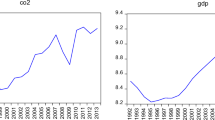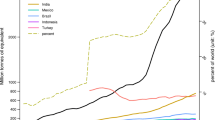Abstract
Since global warming worsens with economic development and emitted CO2 is one of the main greenhouse gases, it is important to understand the relationship between CO2 emissions and economic growth. The paper applies a new panel cointegration test with cross-sectional dependence and structural breaks to examine this relationship in developed and developing countries, respectively. The results indicate that the “Environmental Kuznets Curve” does not hold in either group. For developing countries, there is neither linear nor quadratic long-term equilibrium relationship between CO2 emissions and economic growth. For developed countries, the quadratic relationship does exist between CO2 emissions and economic growth, whereas the linear one does not. A half of these countries have inverted U-shaped curves, while the other half have U-shaped curves. Besides, most of these countries are still on the rising stage of the curve. This paper gives new insights for policymakers to keep a balance between sustainable economic growth and suitable environmental quality.
Similar content being viewed by others
Notes
Wang and Xue (2015). Cointegration with structural breaks in cross-sectional dependent panel. Working Paper. The paper shows the results of ignoring structural breaks by Monte Carlo. These can be obtained upon request from the corresponding author.
\(\mathop = \limits^{d}\) denotes definitional equality, \(\left\lfloor x \right\rfloor\) denotes the integer part of \(x\).
References
Alam MJ, Begum IA, Buysse J, Rahman S, Van Huylenbroeck G (2011) Dynamic modeling of causal relationship between energy consumption, CO2 emissions and economic growth in India. Renew Sustain Energy Rev 15(6):3243–3251
Antonakakis N, Chatziantoniou I, Filis G (2017) Energy consumption, CO2 emissions, and economic growth: an ethical dilemma. Renew Sustain Energy Rev 68:808–824
Arouri MEH, Youssef AB, M’henni H, Rault C (2012) Energy consumption, economic growth and CO2 emissions in Middle East and North African countries. Energy Policy 45:342–349
Azomahou T, Laisney F, Van Phu N (2006) Economic development and CO2 emissions: a nonparametric panel approach. J Public Econ 90:1347–1363
Baek J (2015) Environmental Kuznets curve for CO2 emissions: the case of Arctic countries. Energy Econ 50:13–17
Bai J (2009) Panel data models with interactive fixed effects. Econometrica 77(4):1229–1279
Bai J, Ng S (2004) A PANIC attack on unit roots and cointegration. Econometrica 72(4):1127–1177
Bai J, Perron P (1998) Estimating and testing linear models with multiple structural change. Econometrica 66:47–78
Bai J, Perron P (2003) Computation and analysis of multiple structural change models. J Appl Economet 18:1–22
Bai J, Carrion-i-Silvestre JL (2009) Structural changes, common stochastic trends, and unit roots in panel data. Rev Econ Stud 76:471–501
Bai J, Carrion-i-Silvestre JL (2013) Testing panel cointegration with unobservable dynamic common factors that are correlated with the regressors. Economet J 16:222–249
Banerjee A, Marcellino M, Osbat C (2004) Some cautions on the use of panel methods for integrated series of macroeconomic data. Economet J 7:322–340
Banerjee A, Carrion-i-Silvestre JL (2006) Cointegration in panel data with breaks and cross-section dependence. Working Paper Series No. 591.
Banerjee A, Carrion-i-Silvestre JL (2013) Cointegration in panel data with structural breaks and cross-section dependence. J Appl Econom 30(1):1–23. https://doi.org/10.1002/jae.2348
Begum RA, Sohag K, Abdullah SMS, Jaafar M (2015) CO2 emissions, energy consumption, economic and population growth in Malaysia. Renew Sustain Energy Rev 41:594–601
Bouznit M, Pablo-Romero M del P (2016) CO2 emission and economic growth in Algeria. Energy Policy 96:93–104
Carrion-i-Silvestre JL, Del Barrio-Castro T, Lópes-Bazo E (2005) Breaking the panels: an application to the GDP per capita. Economet J 2(8):159–175
Chen P, Chen S, Hsu C, Chen C (2016) Modeling the global relationships among economic growth, energy consumption and CO2 emissions. Renew Sustain Energy Rev 65:420–431
Churchill SA, Inekwe J, Ivanovski K, Smyth R (2018) The environmental Kuznets curve in the OECD: 1870–2014. Energy Econ 75:389–399
Esteve V, Tamarit C (2012) Threshold co-integration and nonlinear adjustment between CO2 and income: the environmental Kuznets curve in Spain, 1985–2007. Energy Econ 34(6):2148–2156
Fernández-Amador O, Francois JF, Oberdabernig DA, Tomberger P (2017) Carbon dioxide emissions and economic growth: an assessment based on production and consumption emission inventories. Ecol Econ 135:269–279
Fodha M, Zaghdoud O (2010) Economic growth and pollutant emissions in Tunisia: an empirical analysis of the Environmental Kuznets Curve. Energy Policy 38:1150–1156
Ghosh S (2010) Examining carbon emissions economic growth nexus for India: a multivariate cointegration approach. Energy Policy 38(6):3008–3014
Grossman GM, Krueger AB (1991) Environmental impacts of a North American free trade agreement. NBER Working Paper 3914. NBER, Cambridge
Halicioglu F (2009) An econometric study of CO2 emissions, energy consumption, income and foreign trade in Turkey. Energy Policy 37(3):1156–1164
Hamit-Haggar M (2012) Greenhouse gas emissions, energy consumption and economic growth: a panel cointegration analysis from Canadian industrial sector perspective. Energy Econ 34:358–364
Harbaugh W, Levinson A, Wilson D (2002) Reexamining the empirical evidence for an environmental Kuznets curve. Rev Econ Stat 84(3):541–551
Holtz-Eakin D, Selden TM (1995) Stoking the fires? CO2 emissions and economic growth. J Public Econ 57:85–101
Ibrahim HM, Law SH (2014) Social capital and CO2 emissions-output relations: a panel analysis. Renew Sustain Energy Rev 29:528–534
Jalil A, Mahmud SF (2009) Environment Kuznets curve for CO2 emissions: a cointegration analysis for China. Energy Policy 37:5167–5172
Jaunky VC (2011) The CO2 emissions-income nexus: evidence from rich countries. Energy Policy 39:1228–1240
Jiang X, Guan D (2017) The global CO2 emissions growth after international crisis and the role of international trade. Energy Policy 109:734–746
Kasman A, Duman YS (2015) CO2 emissions, economic growth, energy consumption, trade and urbanization in new EU member and candidate countries: a panel data analysis. Econ Model 44:97–103
Kuznets S (1955) Economic growth and income inequality. Am Econ Rev 45:1–28
Lantz V, Feng Q (2006) Assessing income, population, and technology impacts on CO2 emissions in Canada: where’s the EKC? Ecol Econ 57:229–238
Leal PH, Marques AC (2020) Rediscovering the EKC hypothesis for the 20 highest CO2 emitters among OECD countries by level of globalization
Liu Q, Zhao P (2012) The empirical and comparative analysis of carbon dioxide and economic growth in 15 main emitting countries. Inquiry Intro Econ Issues 2:137–144
Maddala GS, Wu S (1999) A comparative study of unit root tests with panel data and a new simple test. Oxf Bull Econ Stat 61(S1):631–652
Moutinho V, Madaleno M, Bento JP (2020) Cointegration and causality: considering Iberian economic activity sectors to test the environmental Kuznets curve hypothesis. Environ Ecol Stat 27:363–413
Narayan PK, Narayan S (2010) Carbon dioxide emissions and economic growth: panel data evidence from developing countries. Energy Policy 38:661–666
Niu S, Ding Y, Li Y, Luo G, Niu Y (2010) Causal relationships among energy consumption, economic growth and carbon emissions. China Soft Sci 5:12–19
Ng S, Perron P (2001) Lag length selection and the construction of unit root tests with good size and power. Econometrica 69:1519–1554
Padilla E, Serrano A (2006) Inequality in CO2 emissions across countries and its relationship with income inequality: a distributive approach. Energy Policy 34:1762–1772
Panayotou T (1993) Empirical tests and policy analysis of environmental degradation at different stages of economic development. Working Paper WP238. Technology and Environment Programme, International Labour Office, Geneva
Pao H, Tsai C (2011) Modelling and forecasting the CO2 emissions, energy consumption, and economic growth in Brazil. Energy 36:2450–2458
Pata UK (2018) Renewable energy consumption, urbanization, financial development, income and CO2 emissions in Turkey: testing EKC hypothesis with structural breaks. J Clean Prod 187:770–779
Pata UK, Aydin M (2020) Testing the EKC hypothesis for the top six hydropower energy-consuming countries: evidence from Fourier Bootstrap ARDL procedure. J Clean Prod 264:121699. https://doi.org/10.1016/j.jclepro.2020.121699
Pesaran MH (2007) A simple panel unit test in the presence of cross-section dependence. J Appl Economet 22:265–312
Peters GP, Marland G, Le Quéré C, Boden T, Canadell JG, Raupach MR (2012) Rapid growth in CO2 emissions after the 2008–2009 global financial crisis. Nat Clim Change 2:2–4
Piaggio M, Padilla E, Román C (2017) The long-term relationship between CO2 emissions and economic activity in a small open economy: Uruguay 1882–2010. Energy Econ 65:271–282
Roinioti A, Koroneos C (2017) The decomposition of CO2 emissions from energy use in Greece before and during the economic crisis and their decoupling from economic growth. Renew Sustain Energy Rev 76:448–459
Saboori B, Sulaiman J, Mohd S (2012) Economic growth and CO2 emissions in Malaysia: a cointegration analysis of the Environmental Kuznets Curve. Energy Policy 51:184–191
Sarkodie SA, Ozturk I (2020) Investigating the Environmental Kuznets Curve hypothesis in Kenya: a multivariate analysis. Renew Sustain Energy Rev 117:109481. https://doi.org/10.1016/j.rser.2019.109481
Sephton P, Mann J (2013) Further evidence of the environmental Kuznets curve in Spain. Energy Econ 36:177–181
Shafik N, Bandyopadhyay S (1992) Economic growth and environmental quality: time series and cross-country evidence. Background Paper for the World Development Report. The World Bank, Washington, DC
Shahbaz M, Mahalik MK, Shah SH, Sato JR (2016) Time-varying analysis of CO2 emissions, energy consumption, and economic growth nexus: statistical experience in next 11 countries. Energy Policy 98:33–48
Shahbaz M, Mahalik MK, Shahzad SJH, Hammoudeh S (2019) Testing the globalization-driven carbon emissions hypothsis: International evidence. Int Econ 158:25–38
Sharma SS (2011) Determinants of carbon dioxide emissions: empirical evidence from 69 countries. Appl Energy 88:376–382
Soberon A, D’Hers I (2020) The Environmental Kuznets Curve: a semiparametric approach with cross-sectional dependence. J Risk Financ Manag MDPI 13:1–23
Ulucak R, Bilgili F (2018) A reinvestigation of EKC model by ecological footprint measurement for high, middle, and low income countries. J Clean Prod 188:144–157
Wang K (2012) Modelling the nonlinear relationship between CO2 emissions from oil and economic growth. Econ Model 29:1537–1547
Wang W, Xue J (2015) Cointegration with structural breaks in cross-sectional dependent panel. Working Paper
Wang W, Xue J, Yu G (2013) Cointegration test with structural breaks and cross-sectional dependence. J Quant Techn Econ 30(5):75–89
Wang W, Xue J, Du C (2016) The Balassa-Samuelson hypothesis in the developed and developing countries revisited. Econ Lett 146:33–38
Wang S, Li G, Fang C (2018) Urbanization, economic growth, energy consumption, and CO2 emissions: empirical evidence from countries with different income level. Renew Sustain Energy Rev 81:2144–2159
Westerlund J, Edgerton DL (2007) New improved tests for cointegration with structural breaks. J Time Ser Anal 28(2):188–224
Westerlund J, Edgerton DL (2008) A simple test for cointegration in dependent panels with structural breaks. Oxford Bull Econ Stat 5(70):665–704
Yavuz NC (2014) CO2 emissions, energy consumption, and economic growth for Turkey: evidence from a cointegration test with a structural break. Energy Sources Part B 9(3):229–235
Zhang Y, Liu Z, Zhang H, Tan T (2014) The impact of economic growth, industrial structure and urbanization on carbon emission intensity in China. Nat Hazards 73(2):579–595
Zoundi Z (2017) CO2 emissions, renewable energy and the Environmental Kuznets Curve, a panel cointegration approach. Renew Sustain Energy Rev 72:1067–1075
Acknowledgements
This work was supported by National Nature Science Foundation of China (Grant number 71773012); National Nature Science Foundation of China (Grant number 71903207); and Scientific research funding projects by the Department of Education of Liaoning Province (20190154).
Author information
Authors and Affiliations
Corresponding author
Additional information
Handling Editor: Luiz Duczmal.
Rights and permissions
About this article
Cite this article
Du, C., Xue, J., Wang, W. et al. Revisiting the carbon emissions hypothesis in the developing and developed countries: a new panel cointegration approach. Environ Ecol Stat 29, 295–314 (2022). https://doi.org/10.1007/s10651-021-00526-z
Received:
Accepted:
Published:
Issue Date:
DOI: https://doi.org/10.1007/s10651-021-00526-z




